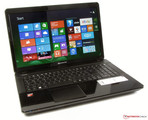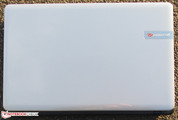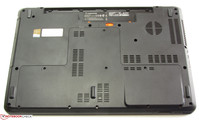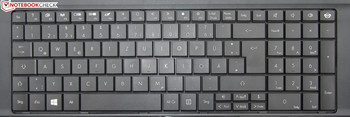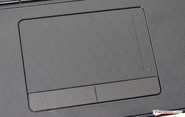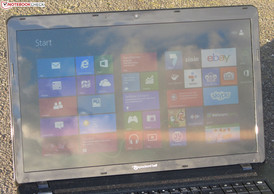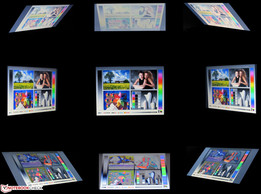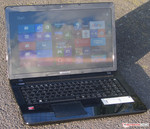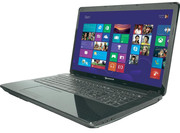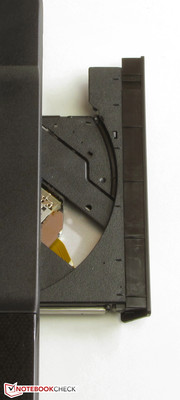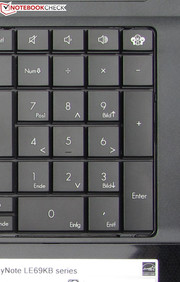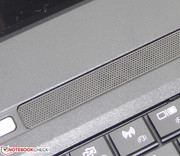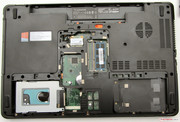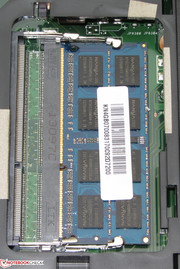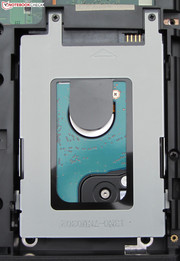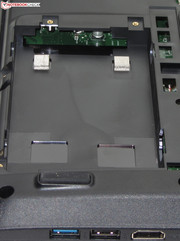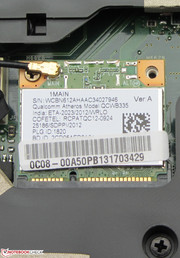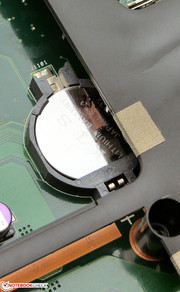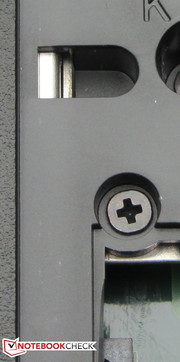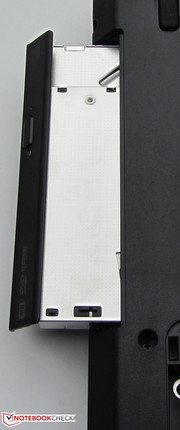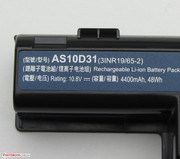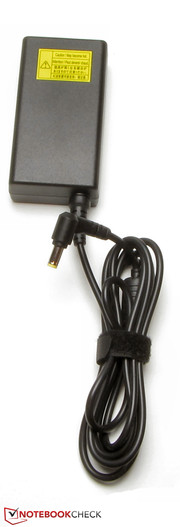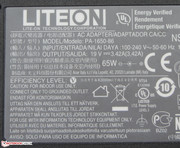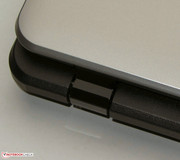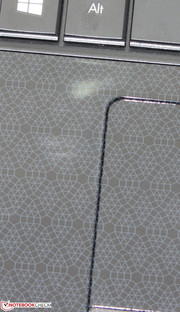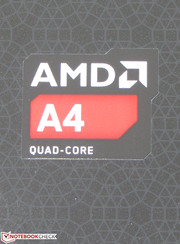Review Packard Bell EasyNote LE69KB-45004G50Mnsk Notebook

For the original German review, see here.
It is not difficult to find an affordable 17.3-inch office laptop. Almost every manufacturer has corresponding models in its product line. Now quad-core processors move into the low-cost sector after AMD released APUs from its new Kabini generation. Packard Bell's EasyNote LE69KB-45004G50Mnsk is such a device. The new APUs are to overpower Intel's Pentium processors and naturally carry off market shares. Whether this undertaking is successful and the user benefits from the four processing cores can be read in our test report.
We used Asus' F75A-TY089H (Pentium B980, HD Graphics (Sandy Bridge)) and Lenovo's G700 (Pentium 2020M, HD Graphics (Ivy Bridge)) to classify the laptop.
Case
Like the EasyNote's purchase price already suggests the casing is completely made of plastic. Packard Bell mixes matte and glossy surfaces. The display's back gleams in a silver-gray color. The wrist rest and display bezel are made in glossy black. The wrist rest additionally features a pattern. The other parts of the base unit are matte black. The casings of both the G700 and F75A are also completely made of plastic.
The EasyNote's base unit is quite rigid. It can be bent slightly below the touchpad. The same is true for the area on the keyboard's right above the DVD burner. The base unit's stiffness could be better. In our opinion, it can be warped a bit too much. This is even truer for the lid. Additionally, the lid's back can be bent to such an extent that image distortions turn up. The hinges keep the lid firmly in place but it wobbles after adjusting. Opening the lid with one hand is possible.
Connectivity
The three compared devices do not differ much in connectivity. All devices feature today's standard ports. The G700 is the only laptop that sports a Fast Ethernet port. The other laptops can serve with Gigabit Ethernet. It is positive that all three computers have one USB 3.0 port. The interface positioning on the EasyNote is worthy of criticism. Most ports are on a level with the wrist rest.
Communication
Packard Bell installs the AR9565 Wi-Fi module from Atheros. It supports the 802.11 b/g/n Wi-Fi standards. Surprisingly, the EasyNote only sports one Wi-Fi antenna although two are common. This leads to fluctuating signal strength. Changing the laptop's position even slightly has an impact on that. Nevertheless, we did not experience any problems with the connection's stability or download speeds. The BCM57780 Gigabit Ethernet chip in the EasyNote comes from Broadcom. Packard Bell has even considered a Bluetooth 4.0 module. The integrated webcam shoots quite decent pictures with a resolution of up to 1280x720 pixels.
Accessories
Only a quick start poster and warranty information are included.
Operating system and Recovery
Packard Bell preinstalls Windows 8 64-bit on the EasyNote. There is no Windows DVD included. Therefore, a recovery DVD should be created via the preinstalled Packard Bell Recovery Management software. It allows resetting the system to its default state in case of defect. The software also enables backing up the installed drivers and applications. Thus, they would be available in case of formatting or replacing the hard drive. Windows 8's recovery system is opened by keeping the F11 key pressed during the booting process.
Using Windows 7 on the EasyNote is possible. However, it requires a bit of manual effort because Packard Bell only supports Windows 8. Windows 7 does not include any drivers for the APU, Wi-Fi module, Gigabit Ethernet chip, memory card reader, chip set or USB 3.0 controller. We could get most components in working order.
- We found a driver for the Wi-Fi module on the Atheros.cz website.
- We got the Ethernet chip running with Broadcom's original driver.
- To get the memory card reader working, the Windows 8 driver from Packard Bell's website can be used.
- The latest APU driver (Catalyst 13.4, 29.05.2013) from AMD's website does not yet support the A4-5000M APU. We therefore tried the newest beta driver (Catalyst 13.8 Beta, 01.08.2013). It works.
- The chip set driver can also be found on AMD's website.
- The latter also lists the USB 3.0 driver. However, the corresponding USB driver is not included yet. Thus, the USB 3.0 port cannot be used at the moment.
Maintenance
The large maintenance cover enables accessing some hardware components. The user can access the working memory, hard drive, Wi-Fi module and BIOS battery. The fan is not accessible. The EasyNote sports two working memory banks. One bank is fitted with a four-gigabyte module. Replacing the hard drive is no problem. Standard 2.5-inch hard drives with a height of 7 and 9.5 mm fit. However, the slot cannot be used since there is no second hard drive connector.
Warranty
Like the F75A, the EasyNote includes a 24-month warranty. Owners of the G700 have to be satisfied with a twelve-month standard warranty. The EasyNote's warranty period can be upgraded to three years for approximately 70 Euros (~$94).
Input Devices
Keyboard
Packard Bell installs a conventional laptop keyboard in the EasyNote. The main keys feature a surface of approximately 16 x 16 mm. The sleek, flat keys feature an overall medium drop and clear pressure point. The keys' resistance is satisfactory but could be a bit crisper. However, that is a matter of taste. The keyboard only wobbles slightly while typing on it, but that is not distracting. Packard Bell supplies an overall surprisingly decent keyboard. We have seen inferior units in low-cost laptops, for example in Asus' F75A.
Touchpad
The multi-touchpad has a size of approximately 10.1 x 6.1 cm (~4.0 x 2.4 inches). Thus, there is enough room for using multi-touch gestures. The pad's surface is lightly roughened and allows easy gliding. The single multi-touch gestures can be enabled and disabled in the configuration menu. The touchpad's sleek mouse keys feature a short drop and a clearly audible and palpable pressure point.
Display
Packard Bell equips the EasyNote with a glossy, 17.3-inch screen that has a resolution of 1600x900 pixels. Other screen models are not available. The EasyNote's average brightness of 242.2 cd/m² is within an acceptable range. The screens in the F75A (219.9 cd/m²) and the G700 (214.6 cd/m²) are not as bright.
| |||||||||||||||||||||||||
Brightness Distribution: 88 %
Center on Battery: 215 cd/m²
Contrast: 467:1 (Black: 0.55 cd/m²)
ΔE Color 10.26 | 0.5-29.43 Ø5
ΔE Greyscale 10.95 | 0.57-98 Ø5.3
49.8% AdobeRGB 1998 (Argyll 1.6.3 3D)
54.5% AdobeRGB 1998 (Argyll 2.2.0 3D)
76% sRGB (Argyll 2.2.0 3D)
52.7% Display P3 (Argyll 2.2.0 3D)
Gamma: 3.08
The EasyNote supplies quite satisfactory rates with a contrast of 467:1 and a black value of 0.55 cd/m². We frequently encounter worse rates in the low-cost sector, like in the F75A (291:1, 0.6 cd/m²). The EasyNote's screen cannot reproduce the AdobeRGB or sRGB color space. But that will be uninteresting for most users because these color spaces are only important for professional image editing.
We assessed the screen in state of delivery (target color space: sRGB). The DeltaE 2000 deviation of almost all colors is higher than five. Only blue is within the target range (DeltaE <5). Consequently, the screen has a shift of cyan and magenta towards blue, but it nevertheless exhibits a visible bluish cast.
Outdoor use is quite possible although very bright surroundings should be avoided. The reflective screen would otherwise ruin any plans in this direction.
The common problem of low-cost laptops becomes obvious here. Changing the viewing angle vertically quickly leads to image distortions. It is better horizontally. The image remains stable over a larger angle and the content is legible from the sides. However, the image dims.
Performance
With the EasyNote LE69KB, Packard Bell offers a basic office laptop in a 17.3-inch size that makes a good impression in routine application scenarios. Users who want a computer for browsing, typing, Skype calls, etc. will not be disappointed by the EasyNote. Video playback is not a problem for the laptop either. This includes Full HD videos (1920x1080 pixels) and H.264 encoding. Computer games can only be played to an extent. The EasyNote is available for around 400 Euros (~$536). We did not find other models within the LE69KB series.
Processor
The EasyNote sports an AMD A4-5000 APU that comes from the Kabini generation. The Kabini APUs are based on AMD's current Jaguar architecture that will also be installed in the upcoming XBox One and PlayStation 4 game consoles. The CPU part of the APU is a quad-core processor with a clock of 1.5 GHz. AMD specifies a TDP of 15 Watts for the APU. More information and many tests can be found in our short review of the A4-5000 APU.
The processor consistently clocked with its full speed of 1.5 GHz in both AC and battery mode in the Cinebench tests. The EasyNote lags behind the F75A (Pentium B980, HD Graphics) and the G700 (Pentium 2020, HD Graphics) in all CPU tests. Intel's processors can display their much higher clock (2.4 GHz) here. The APU is quite able to compete with the equally fast Intel processor in the multi-thread tests and even beat them, for example Intel's Pentium 987 and Core i3-2367M. It does not look as good in the single thread tests though. The APU cannot pull even with its Intel counterparts here. The APU outscores an equivalent Intel processor in applications optimized for parallelization.
The three devices are on a par in the Cinebench 10 GL tests but the EasyNote wins the Cinebench R11.5 GL benchmark. The Radeon GPU achieves a rate that is on a level with the HD Graphics 4000.
| Cinebench R11.5 - CPU Multi 64Bit (sort by value) | |
| Packard Bell EasyNote LE69KB-45004G50Mnsk | |
| Lenovo B575e | |
| Acer Aspire V5-551-64454G50Makk | |
| Asus K53TK-SX114V | |
| Acer Aspire One 756 NU.SH0EG.007 | |
| Lenovo ThinkPad Edge E130 (NZU36PB) | |
| Samsung Serie 3 355E7C-S05DE | |
| Asus F75A-TY089H | |
| Lenovo G700 | |
| HP Pavilion g6-2253sg | |
| Packard Bell EasyNote TS11SB-250GE | |
| Asus F75VC-TY088H | |
System Performance
We experienced delays in opening applications. Some time elapsed from the mouse click and the start of a program. Apart from that, the system worked quite smoothly. The scores of the PCMark benchmarks lag far behind those of the F75A (Pentium B980, HD Graphics) and the G700 (Pentium 2020M, HD Graphics). Both laptops sport stronger processors.
The system was much more responsive with a solid-state drive. Windows booted faster and the delays when opening applications were eliminated. We tried this out and it had a positive effect on the PCMark benchmarks. Our Crucial RealSSD C300 64-bit SSD improved the PCMark 7 score by almost 62 percent to 2343 points. The PCMark Vantage score even increased by 93 percent to 6106 points.
A higher performance in many laptops could also be achieved by installing a second working memory module. This is not possible in the EasyNote because the APU-integrated memory controller only supports single-channel mode. AMD's APU could be maxed out better and supply better computing results if the controller supported dual-channel mode. It would also boost the frame rates in games.
| PCMark Vantage Result | 3154 points | |
| PCMark 7 Score | 1463 points | |
Help | ||
Storage Devices
Packard Bell installs a Toshiba hard drive in the EasyNote. It features a capacity of 500 GB and spins at 5400 revolutions per minute. CrystalDiskMark recorded a read rate of 101.6 MB/s and HD Tune delivered an average transfer speed of 84.7 MB/s. These are good rates for a 5400-rpm hard drive.
Graphics Card
The Radeon HD 8330 core is responsible for graphics output. It supports DirectX 11.1 and clocks with 500 MHz. It does not feature a Turbo. The EasyNote achieved better scores than the F75A (Pentium B980, HD Graphics (Sandy Bridge)) and the G700 (Pentium 2020M, HD Graphics (Ivy Bridge)) in all 3DMark benchmarks. The Radeon GPU's score is on a par with Intel's HD Graphics 4000 GPU in the 3DMark 2011 benchmark. The CPU does not have much of an impact on the score in this benchmark and thus contributes to the good impression of the GPU's performance.
| 3DMark 06 Standard Score | 3328 points | |
| 3DMark Vantage P Result | 1909 points | |
| 3DMark 11 Performance | 600 points | |
| 3DMark Ice Storm Standard Score | 25698 points | |
| 3DMark Cloud Gate Standard Score | 2266 points | |
| 3DMark Fire Strike Score | 362 points | |
Help | ||
| 3DMark 11 - 1280x720 Performance (sort by value) | |
| Packard Bell EasyNote LE69KB-45004G50Mnsk | |
| Lenovo G700 | |
| Lenovo B580-M94A5GE | |
| Asus F75VC-TY088H | |
Gaming Performance
The EasyNote is not designed for computer games. Nevertheless, it is possible to play a few titles in low resolution and low quality settings. Its performance is quite comparable with Intel's HD Graphics 4000 GPU as long as the CPU does not slow down the Radeon graphics core.
Users searching for an affordable, gaming suitable laptop should look at the Asus F75VC. It is identical with the F75A but provides considerably more gaming power owing to a Core i3-2370M processor and GeForce GT 720M. Another alternative would be Acer's Aspire V3-771G. It features an entry-level Core i3 processor and GeForce GT 630M GPU for approximately 500 Euros (~$670).
| low | med. | high | ultra | |
| Trackmania Nations Forever (2008) | 72.1 | 22.2 | ||
| Resident Evil 5 (2009) | 43.8 | 22.2 | ||
| Total War: Shogun 2 (2011) | 56.9 | 10 | ||
| Deus Ex Human Revolution (2011) | 36.4 | 17.2 | ||
| Batman: Arkham City (2011) | 26 | |||
| The Elder Scrolls V: Skyrim (2011) | 18.2 | 13.5 | ||
| Anno 2070 (2011) | 37.2 | 14.8 | ||
| Mass Effect 3 (2012) | 18.7 | 14.1 | ||
| Risen 2: Dark Waters (2012) | 13.8 | 9.1 | ||
| Max Payne 3 (2012) | 15.1 | 14.2 | ||
| F1 2012 (2012) | 29 | 25 | 22 | |
| Medal of Honor: Warfighter (2012) | 18.5 | |||
| Need for Speed: Most Wanted (2012) | 17 | |||
| Assassin´s Creed III (2012) | 10.1 | |||
| Far Cry 3 (2012) | 18.8 | 11.5 | ||
| Dead Space 3 (2013) | 41.6 | 17.1 | 13.1 | |
| Tomb Raider (2013) | 26.8 | 13.6 | ||
| StarCraft II: Heart of the Swarm (2013) | 61.7 | 26.3 | 13.5 | |
| Dota 2 (2013) | 22.9 | 16.9 |
| The Elder Scrolls V: Skyrim - 1280x720 Low Preset (sort by value) | |
| Packard Bell EasyNote LE69KB-45004G50Mnsk | |
| Lenovo G700 | |
| Asus F75A-TY089H | |
| Lenovo B580-M94A5GE | |
| Asus F75VC-TY088H | |
| The Elder Scrolls V: Skyrim - 1366x768 Medium Preset AA:4x (sort by value) | |
| Packard Bell EasyNote LE69KB-45004G50Mnsk | |
| Lenovo G700 | |
| Asus F75A-TY089H | |
| Lenovo B580-M94A5GE | |
| Asus F75VC-TY088H | |
Emissions
System Noise
We ascertained a noise level of 29.6 dB(A) during idle mode. This is the base noise of the measuring room. The fan was always inactive. The rate increased to 30.2 dB(A) as soon as the hard drive started to work, which will only be audible in very quiet surroundings. The G700 (30.6 to 30.7 dB(A)) and the F75A (30.8 to 31.8 dB(A)) are not bad either and also excel with low rates. The fan increases its speed when the laptop is loaded, but it remains at a low level. The noise level during medium load via 3DMark 06 was 30 dB(A) and 31.5 dB(A) in full load during the stress test using Prime95 and FurMark. The G700's rate slightly surpasses that with 32.1 dB(A) and the F74A produces a much higher noise level, particularly during high load, with 32.6 dB(A) and 38.6 dB(A). Users looking for a quiet laptop will be satisfied with the EasyNote.
Noise Level
| Idle |
| 29.6 / 29.6 / 29.6 dB(A) |
| HDD |
| 30.2 dB(A) |
| DVD |
| 36.7 / dB(A) |
| Load |
| 30 / 31.3 dB(A) |
 | ||
30 dB silent 40 dB(A) audible 50 dB(A) loud |
||
min: | ||
Temperature
As expected, the EasyNote's temperatures are not exceedingly high. The temperatures on the laptop's outsides were roughly 30 degrees Celsius (86 degrees Fahrenheit) in both idle mode and full load. Thus, it would be possible to place the laptop on the thighs in all scenarios. The G700 and F75A are on a par with the EasyNote's temperatures. Both laptops only surpass 40 degrees Celsius (104 Fahrenheit) during full load in the area around the vent.
The CPU and GPU can always provide their maximum computing power. Both the CPU and GPU performed the stress test (Prime95 and FurMark run for at least one hour) at full speed in both AC and battery mode (CPU: 1.5 GHz, GPU: 500 MHz). The CPU's temperature settled to approximately 61 degrees Celsius (141.8 Fahrenheit) in AC mode.
(+) The maximum temperature on the upper side is 33.4 °C / 92 F, compared to the average of 34.2 °C / 94 F, ranging from 21.2 to 62.5 °C for the class Office.
(+) The bottom heats up to a maximum of 34.6 °C / 94 F, compared to the average of 36.7 °C / 98 F
(+) In idle usage, the average temperature for the upper side is 29 °C / 84 F, compared to the device average of 29.5 °C / 85 F.
(+) The palmrests and touchpad are reaching skin temperature as a maximum (32 °C / 89.6 F) and are therefore not hot.
(-) The average temperature of the palmrest area of similar devices was 27.7 °C / 81.9 F (-4.3 °C / -7.7 F).
Speakers
The EasyNote's stereo speakers are underneath a perforated cover above the keyboard. The sound lacks bass and it tends to sound tinny. Users who place value on a better sound experience should use headphones or external speakers.
Energy Management
Power Consumption
The EasyNote excels with low idle power consumption from 6.5 to 10.6 Watts owing to the energy-efficient Kabini APU. The G700 (6.6 to 12 Watts) only consumes a bit more power. The F75A (10.4 to 16.6 Watts) is considerably more consuming. The EasyNote clearly breaks away from its contenders in medium load via 3DMark 06 with 19.6 Watts and 24.6 Watts in full load via the stress test using Prime95 and FurMark. The G700 (27.9 and 35.7 Watts) and the F75A (27.6 and 47.2 Watts) cannot compete with that.
| Off / Standby | |
| Idle | |
| Load |
|
Battery Runtime
The low power consumption over the entire load range promises good battery runtimes. The EasyNote lasted for 10:34 h in idle mode. Although it is hard to believe, the G700 (13:13 h) clearly surpasses this good rate. The F75A (5:25 h) is very far behind that. The idle runtime is ascertained using the Battery Eater test. The screen's brightness is set to minimum, the energy-saving profile is enabled and the wireless modules are off. The EasyNote was drained after 2:18 h of load. Both the G700 (1:12 h) and the F75A (1:05 h) shut down earlier. Load is simulated with Battery Eater Classic test. The screen's brightness is set to maximum, the high-performance profile and the wireless modules are enabled.
The EasyNote ran the Wi-Fi test for 5:01 h. The G700 lasts for 15 minutes more and the F75A (3:29 h) is drained sooner. Websites are opened automatically every 40 seconds, the energy-saving profile is enabled and the screen's brightness is set to approximately 150 cd/m² in the Wi-Fi test. DVD playback stopped after 4:05 h on the EasyNote. The batteries in the G700 (2:58 h) and F75A (2:45 h) are drained sooner. The DVD test is performed using enabled energy-saving mode or a higher profile should the DVD not run smoothly, maximum brightness and disabled wireless modules.
The runtimes of the three laptops can be compared well because their batteries have a similar capacity (Packard Bell and Lenovo: 48 Wh; Asus: 47 Wh).
Verdict
All in all, Packard Bell's EasyNote LE69KB makes a good impression. AMD now actually has a contender for the Pentium processors in its product line with the Kabini APUs. The APU can outperform the equally clocked Pentium in multi-thread applications. The APU can even defeat equally clocked Core i3 processors. Its computing power is more than enough for taking care of routine work (like writing emails, browsing, office tasks, etc.). The laptop also runs very quietly and consumes little power. Together with the satisfactory keyboard, the EasyNote makes concentrated working possible. The battery runtimes are also very good and the screen is acceptable. Asus' F75A and Lenovo's G700 come into question when more CPU power is needed. Both laptops have more to offer in this regard.


 Deutsch
Deutsch English
English Español
Español Français
Français Italiano
Italiano Nederlands
Nederlands Polski
Polski Português
Português Русский
Русский Türkçe
Türkçe Svenska
Svenska Chinese
Chinese Magyar
Magyar